Combustion and Emissions Optimization of Diesel–Methanol Dual-Fuel Engine: Emphasis on Valve Phasing and Injection Parameters
Abstract
1. Introduction
2. Numerical Models and Methodology
2.1. Engine Models
2.2. Numerical Models and Validations
2.3. Operation Conditions
3. Results and Discussion
3.1. Optimization of Engine Valve Phasing
3.2. Effects of Injection Phasing on Engine Performance
3.3. Effects of Injection Pressure on Engine Performance
3.4. Effects of Nozzle Diameter on Engine Performance
4. Conclusions
Author Contributions
Funding
Data Availability Statement
Conflicts of Interest
Abbreviations
References
- Lian, Z.; Li, W.; Cai, Y.; Chen, H.; Jiang, J.; Li, G.; Zhao, F.; Yu, W. Investigations of diesel and natural gas injection interaction on combustion characteristics of a high-pressure direct-injection dual-fuel engine based on large eddy simulation. Appl. Energy 2025, 378, 124807. [Google Scholar] [CrossRef]
- Zhao, W.; Li, Z.; Huang, G.; Zhang, Y.; Qian, Y.; Lu, X. Experimental investigation of direct injection dual fuel of n-butanol and biodiesel on Intelligent Charge Compression Ignition (ICCI) Combustion mode. Appl. Energy 2020, 266, 114884. [Google Scholar] [CrossRef]
- Gong, C.; Li, Z.; Sun, J.; Liu, F. Evaluation on combustion and lean-burn limit of a medium compression ratio hydrogen/methanol dual-injection spark-ignition engine under methanol late-injection. Appl. Energy 2020, 277, 115622. [Google Scholar] [CrossRef]
- Wang, X.; Gao, J.; Chen, Z.; Chen, H.; Zhao, Y.; Huang, Y.; Chen, Z. Evaluation of hydrous ethanol as a fuel for internal combustion engines: A review. Renew. Energy 2022, 194, 504–525. [Google Scholar] [CrossRef]
- Verhelst, S.; Turner, J.W.G.; Sileghem, L.; Vancoillie, J. Methanol as a fuel for internal combustion engines. Prog. Energy Combust. Sci. 2019, 70, 43–88. [Google Scholar] [CrossRef]
- Su, L.-W.; Li, X.-R.; Sun, Z.-Y. The consumption, production and transportation of methanol in China: A review. Energy Policy 2013, 63, 130–138. [Google Scholar] [CrossRef]
- Huang, Z.; Lu, H.; Jiang, D.; Zeng, K.; Liu, B.; Zhang, J.; Wang, X. Engine performance and emissions of a compression ignition engine operating on the diesel-methanol blends. Proc. Inst. Mech. Eng. Part D J. Automob. Eng. 2004, 218, 435–447. [Google Scholar] [CrossRef]
- Udayakumar, R.; Sundaram, S.; Sivakumar, K. Engine performance and exhaust characteristics of dual fuel operation in DI diesel engine with methanol. In SAE Technical Paper; SAE International: Warrendale, PA, USA, 2004; ISSN 0148-7191. [Google Scholar]
- Tian, Z.; Wang, Y.; Zhen, X.; Liu, Z. The effect of methanol production and application in internal combustion engines on emissions in the context of carbon neutrality: A review. Fuel 2022, 320, 123902. [Google Scholar] [CrossRef]
- Jin, C.; Ding, C.; Hu, J.; Geng, Z.; Li, X.; Dong, J.; Xu, T.; Liu, H. Study on the stability and properties of carbon neutral methanol in blends with diesel fuel. Fuel 2024, 374, 132453. [Google Scholar] [CrossRef]
- Song, R.; Liu, J.; Wang, L.; Liu, S. Performance and Emissions of a Diesel Engine Fuelled with Methanol. Energy Fuels 2008, 22, 3883–3888. [Google Scholar] [CrossRef]
- Wang, Q.; Wei, L.; Pan, W.; Yao, C. Investigation of operating range in a methanol fumigated diesel engine. Fuel 2015, 140, 164–170. [Google Scholar] [CrossRef]
- Agarwal, A.K.; Kumar, V.; Jena, A.; Kalwar, A. Fuel injection strategy optimisation and experimental performance and emissions evaluation of diesel displacement by port fuel injected methanol in a retrofitted mid-size genset engine prototype. Energy 2022, 248, 123593. [Google Scholar] [CrossRef]
- Wei, L.; Yao, C.; Han, G.; Pan, W. Effects of methanol to diesel ratio and diesel injection timing on combustion, performance and emissions of a methanol port premixed diesel engine. Energy 2016, 95, 223–232. [Google Scholar] [CrossRef]
- Karvounis, P.; Theotokatos, G.; Patil, C.; Xiang, L.; Ding, Y. Parametric investigation of diesel–methanol dual fuel marine engines with port and direct injection. Fuel 2025, 381, 133441. [Google Scholar] [CrossRef]
- Zang, R.; Yao, C. Numerical Study of Combustion and Emission Characteristics of a Diesel/Methanol Dual Fuel (DMDF) Engine. Energy Fuels 2015, 29, 3963–3971. [Google Scholar] [CrossRef]
- Liu, J.; Yao, A.; Yao, C. Effects of injection timing on performance and emissions of a HD diesel engine with DMCC. Fuel 2014, 134, 107–113. [Google Scholar] [CrossRef]
- Altun, Ş.; Fırat, M.; Varol, Y.; Okcu, M. Comparison of direct and port injection of methanol in a RCCI engine using diesel and biodiesel as high reactivity fuels. Process Saf. Environ. Prot. 2023, 174, 681–693. [Google Scholar] [CrossRef]
- Panda, K.; Ramesh, A. Parametric investigations to establish the potential of methanol based RCCI engine and comparison with the conventional dual fuel mode. Fuel 2022, 308, 122025. [Google Scholar] [CrossRef]
- Qu, G.; Yao, A.; Chen, C.; Ren, J.; Yao, C. Effect of EGR strategy on combustion and emission of DMDF engine for meeting China VI emission legislation. Fuel 2021, 299, 120879. [Google Scholar] [CrossRef]
- Wang, J.; Chen, L.; Chen, J. Experimental investigation on combustion and emission characteristics of diesel methanol dual fuel (DMDF) engine at various altitudes. Energy Environ. 2024, 35, 331–352. [Google Scholar] [CrossRef]
- Kumar, D.; Sonawane, U.; Chandra, K.; Agarwal, A.K. Experimental investigations of methanol fumigation via port fuel injection in preheated intake air in a single cylinder dual-fuel diesel engine. Fuel 2022, 324, 124340. [Google Scholar] [CrossRef]
- Wang, Q.; Yao, C.; Dou, Z.; Wang, B.; Wu, T. Effect of intake pre-heating and injection timing on combustion and emission characteristics of a methanol fumigated diesel engine at part load. Fuel 2015, 159, 796–802. [Google Scholar] [CrossRef]
- Guan, W.; Wang, X.; Zhao, H.; Liu, H. Exploring the high load potential of diesel–methanol dual-fuel operation with Miller cycle, exhaust gas recirculation, and intake air cooling on a heavy-duty diesel engine. Int. J. Engine Res. 2021, 22, 2318–2336. [Google Scholar] [CrossRef]
- Chen, Z.; Yao, C.; Wang, Q.; Han, G.; Dou, Z.; Wei, H.; Wang, B.; Liu, M.; Wu, T. Study of cylinder-to-cylinder variation in a diesel engine fueled with diesel/methanol dual fuel. Fuel 2016, 170, 67–76. [Google Scholar] [CrossRef]
- Wei, F.; Zhang, Z.; Wei, W.; Zhang, H.; Cai, W.; Dong, D.; Li, G. Multi-objective optimization of the performance for a marine methanol-diesel dual-fuel engine. Fuel 2024, 368, 131556. [Google Scholar] [CrossRef]
- Dierickx, J.; Verbiest, J.; Janvier, T.; Peeters, J.; Sileghem, L.; Verhelst, S. Retrofitting a high-speed marine engine to dual-fuel methanol-diesel operation: A comparison of multiple and single point methanol port injection. Fuel Commun. 2021, 7, 100010. [Google Scholar] [CrossRef]
- Xu, G.; García, A.; Jia, M.; Monsalve-Serrano, J. Computational optimization of the piston bowl geometry for the different combustion regimes of the dual-mode dual-fuel (DMDF) concept through an improved genetic algorithm. Energy Convers. Manag. 2021, 246, 114658. [Google Scholar] [CrossRef]
- Li, Y.; Chen, H.; Zhang, C.; Chen, H. Effects of diesel pre-injection on the combustion and emission characteristics of a common-rail diesel engine fueled with diesel-methanol dual-fuel. Fuel 2021, 290, 119824. [Google Scholar] [CrossRef]
- Senecal, P.; Pomraning, E.; Richards, K.; Briggs, T.; Choi, C.; McDavid, R.; Patterson, M. Multi-dimensional modeling of direct-injection diesel spray liquid length and flame lift-off length using CFD and parallel detailed chemistry. SAE Trans. 2003, 112, 1331–1351. [Google Scholar]
- Mehl, M.; Pitz, W.J.; Westbrook, C.K.; Curran, H.J. Kinetic modeling of gasoline surrogate components and mixtures under engine conditions. Proc. Combust. Inst. 2011, 33, 193–200. [Google Scholar] [CrossRef]
- Mehl, M.; Pitz, W.J.; Sjöberg, M.; Dec, J.E. Detailed Kinetic Modeling of Low-Temperature Heat Release for PRF Fuels in an HCCI Engine. In SAE Technical Paper; SAE International: Warrendale, PA, USA, 2009. [Google Scholar] [CrossRef]
- Curran, H.J.; Gaffuri, P.; Pitz, W.J.; Westbrook, C.K. A Comprehensive Modeling Study of n-Heptane Oxidation. Combust. Flame 1998, 114, 149–177. [Google Scholar] [CrossRef]
- Zhou, C.-W.; Li, Y.; Burke, U.; Banyon, C.; Somers, K.P.; Ding, S.; Khan, S.; Hargis, J.W.; Sikes, T.; Mathieu, O.; et al. An experimental and chemical kinetic modeling study of 1,3-butadiene combustion: Ignition delay time and laminar flame speed measurements. Combust. Flame 2018, 197, 423–438. [Google Scholar] [CrossRef]
- Olm, C.; Varga, T.; Valkó, É.; Curran, H.J.; Turányi, T. Uncertainty quantification of a newly optimized methanol and formaldehyde combustion mechanism. Combust. Flame 2017, 186, 45–64. [Google Scholar] [CrossRef]
- Han, Z.; Reitz, R.D. Turbulence Modeling of Internal Combustion Engines Using RNG κ-ε Models. Combust. Sci. Technol. 1995, 106, 267–295. [Google Scholar] [CrossRef]
- Angelberger, C.; Poinsot, T.; Delhay, B. Improving Near-Wall Combustion and Wall Heat Transfer Modeling in SI Engine Computations. In SAE Technical Paper; SAE International: Warrendale, PA, USA, 1997. [Google Scholar] [CrossRef]
- Beale, J.C.; Reitz, R.D. Modeling spray atomization with the Kelvin-Helmholtz/Rayleigh-Taylor hybrid model. At. Sprays 1999, 9, 623–650. [Google Scholar]
- O’Rourke, P.J.; Amsden, A. A spray/wall interaction submodel for the KIVA-3 wall film model. SAE Trans. 2000, 109, 281–298. [Google Scholar]
- O’rourke, P.; Amsden, A. A particle numerical model for wall film dynamics in port-injected engines. SAE Trans. 1996, 105, 2000–2013. [Google Scholar]
- Reitz, R.; Bracco, F. Mechanism of atomization of a liquid jet. Phys. Fluids 1982, 25, 1730–1742. [Google Scholar] [CrossRef]
- Taskiran, O.O.; Ergeneman, M. Trajectory based droplet collision model for spray modeling. Fuel 2014, 115, 896–900. [Google Scholar] [CrossRef]
- Heywood, J.B. Internal Combustion Engine Fundamentals, 1st ed.; McGraw-Hill Education: Columbus, OH, USA, 1988; Volume 25, pp. 1117–1128. [Google Scholar]
- Hiroyasu, H.; Kadota, T. Models for combustion and formation of nitric oxide and soot in direct injection diesel engines. SAE Trans. 1976, 85, 513–526. [Google Scholar]



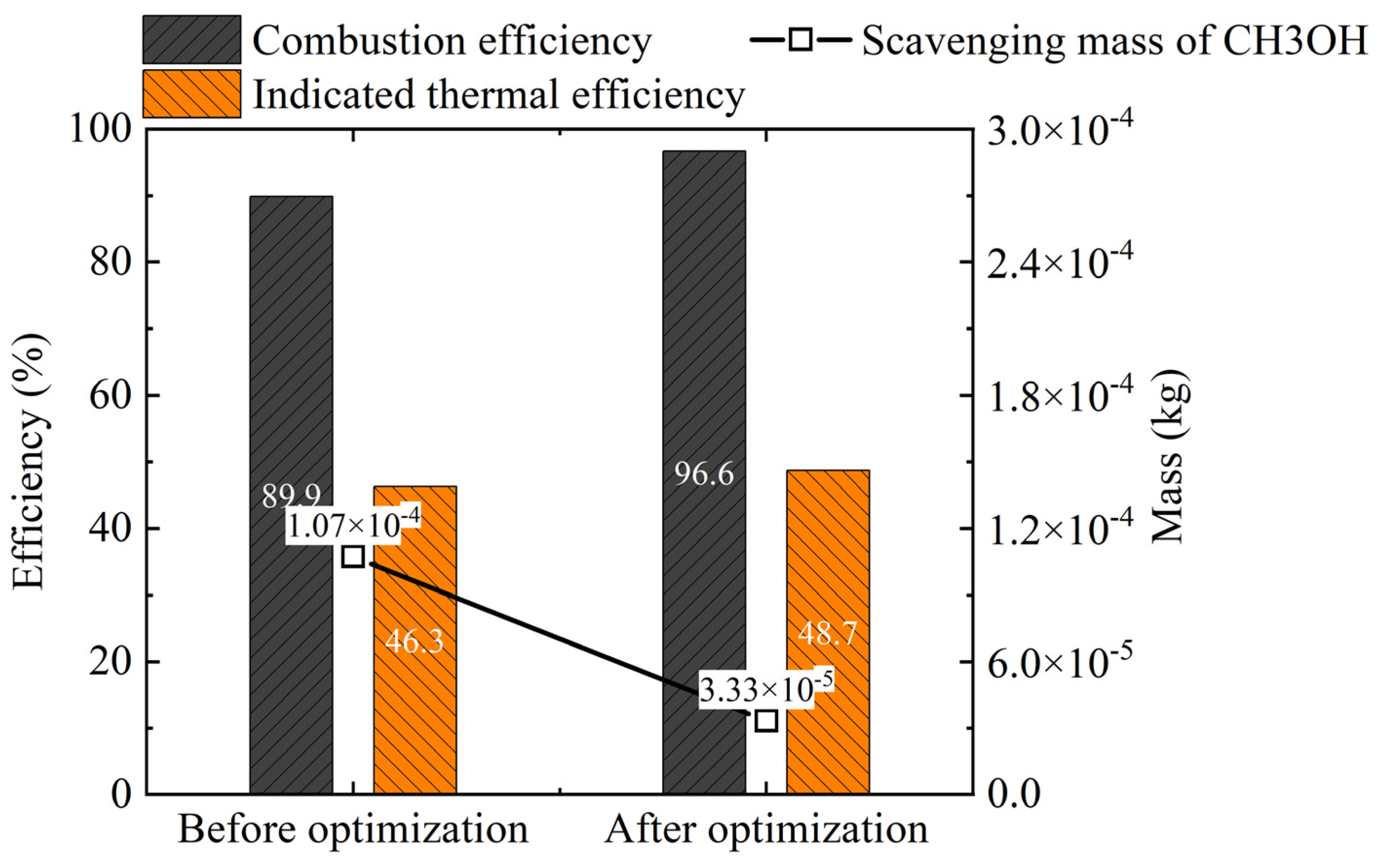

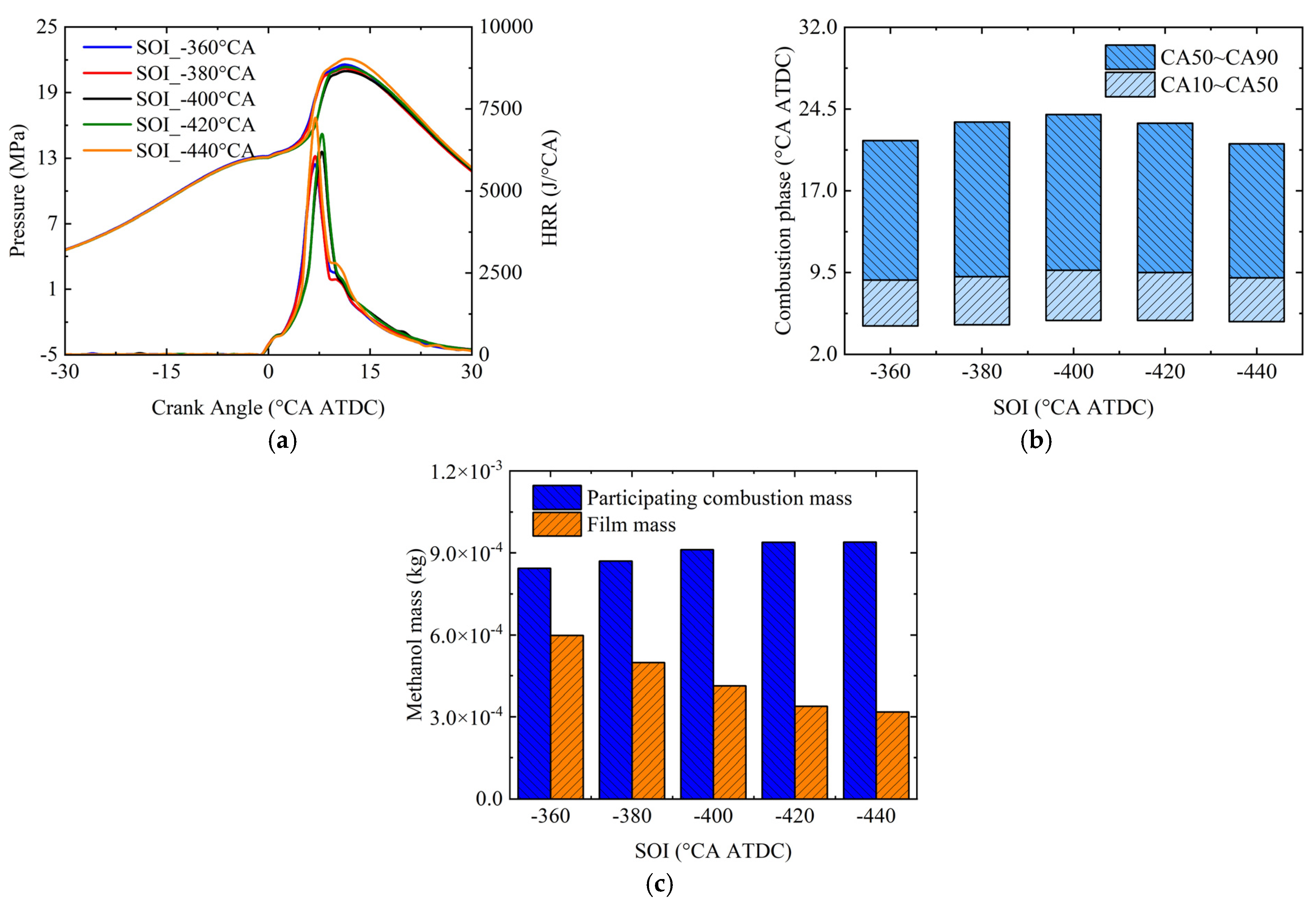
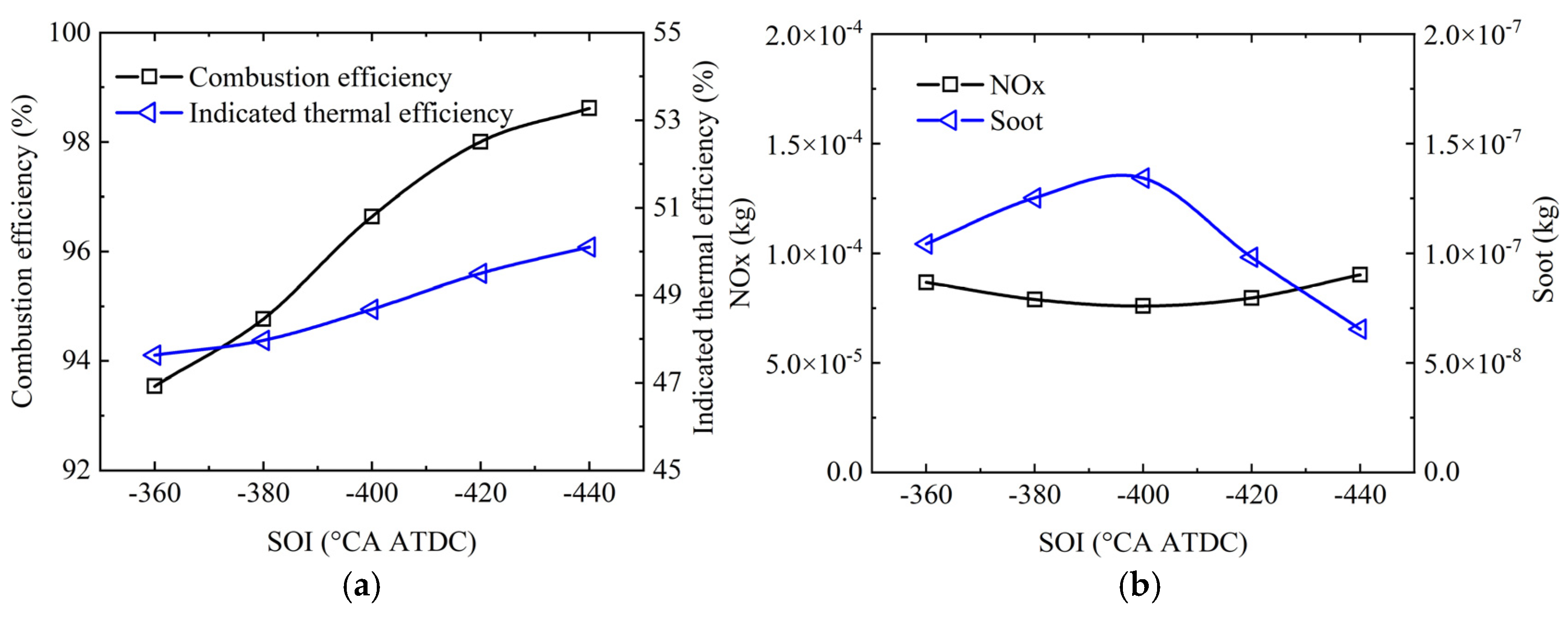
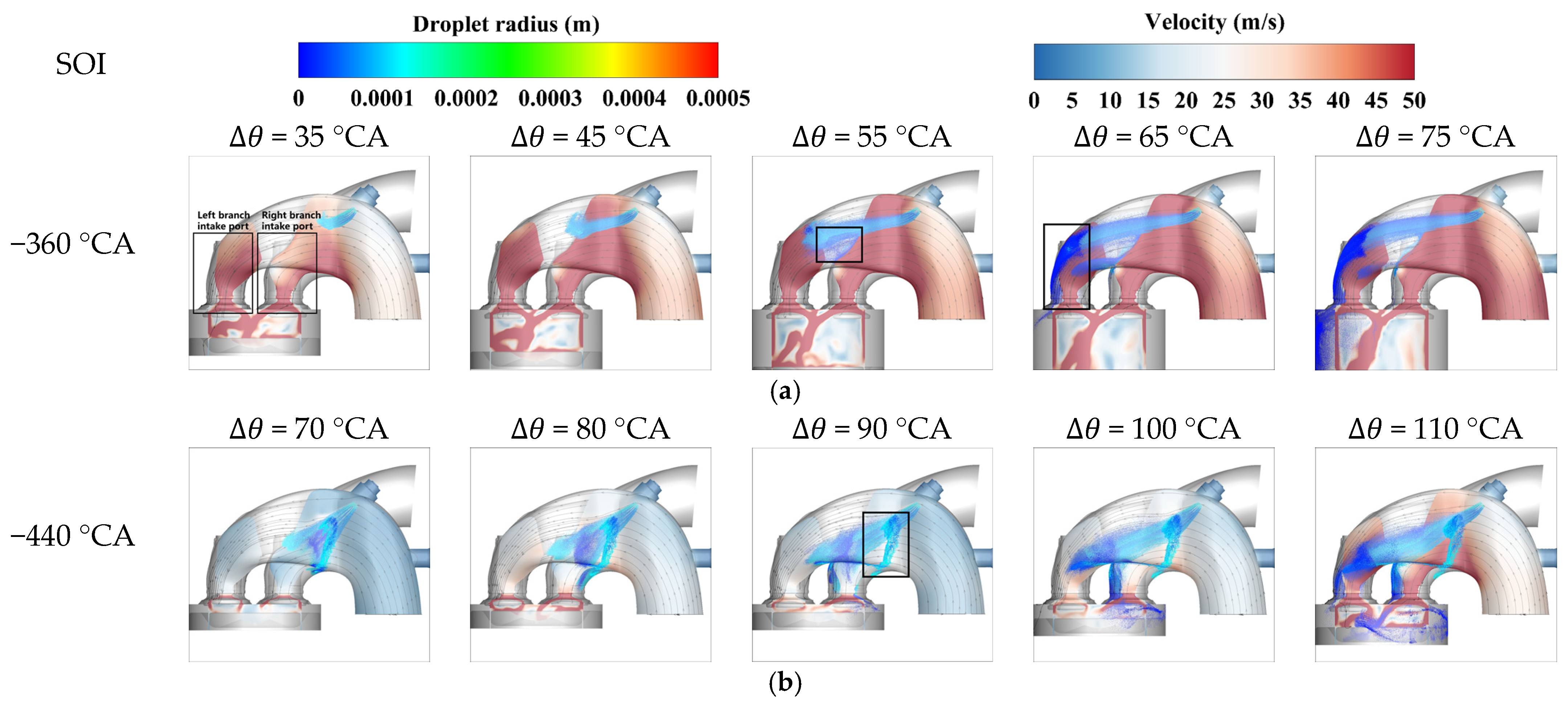
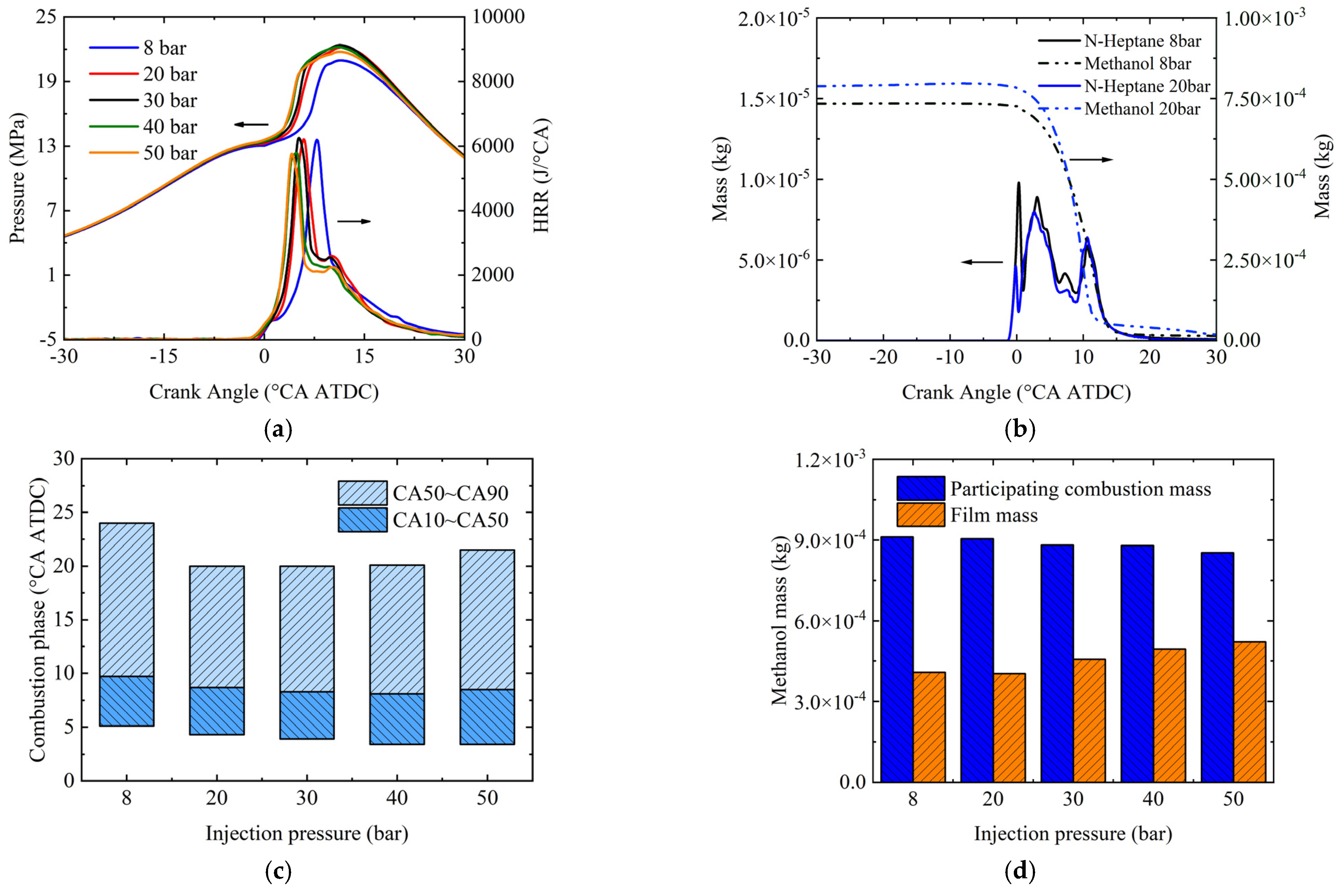

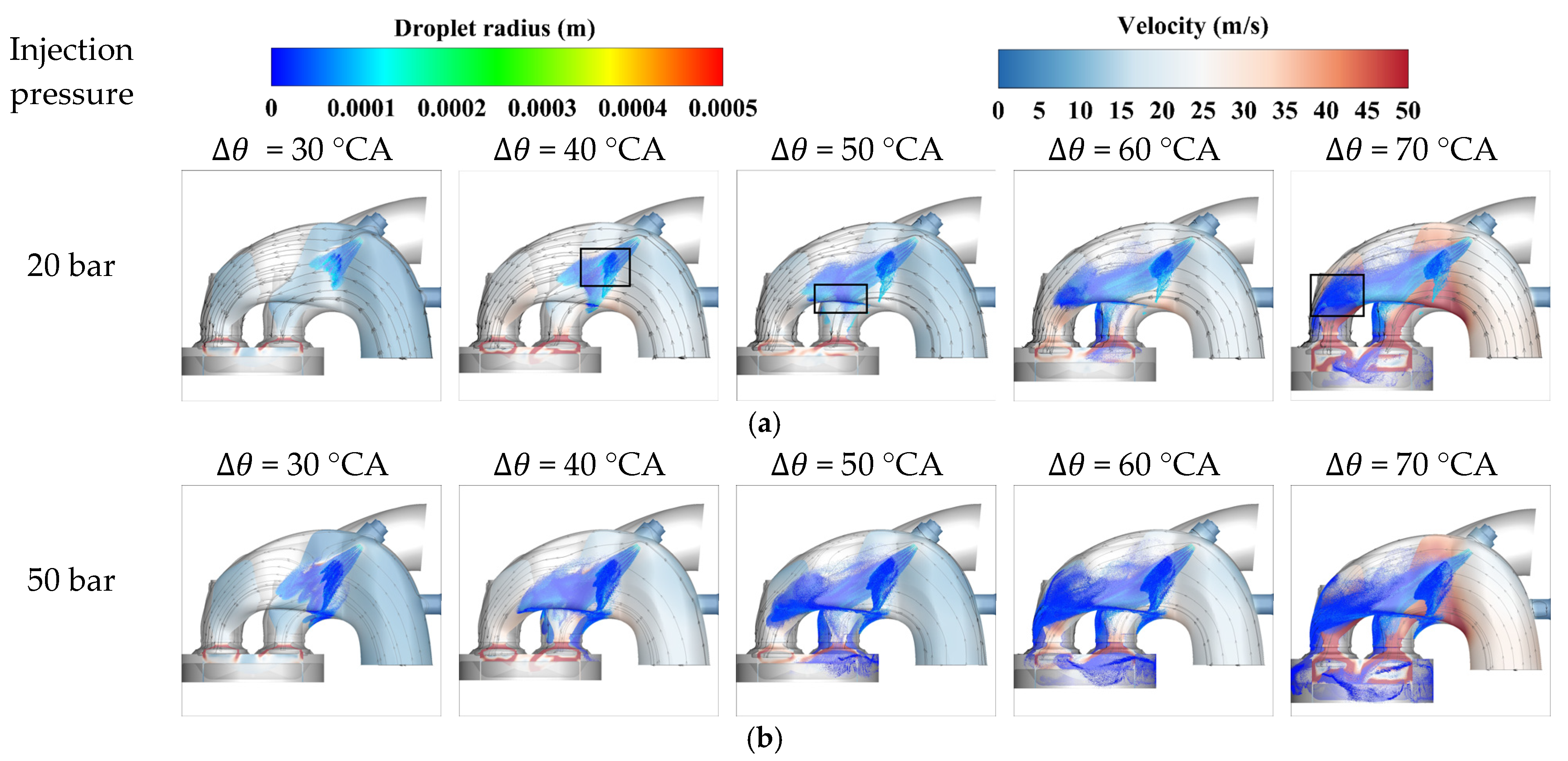
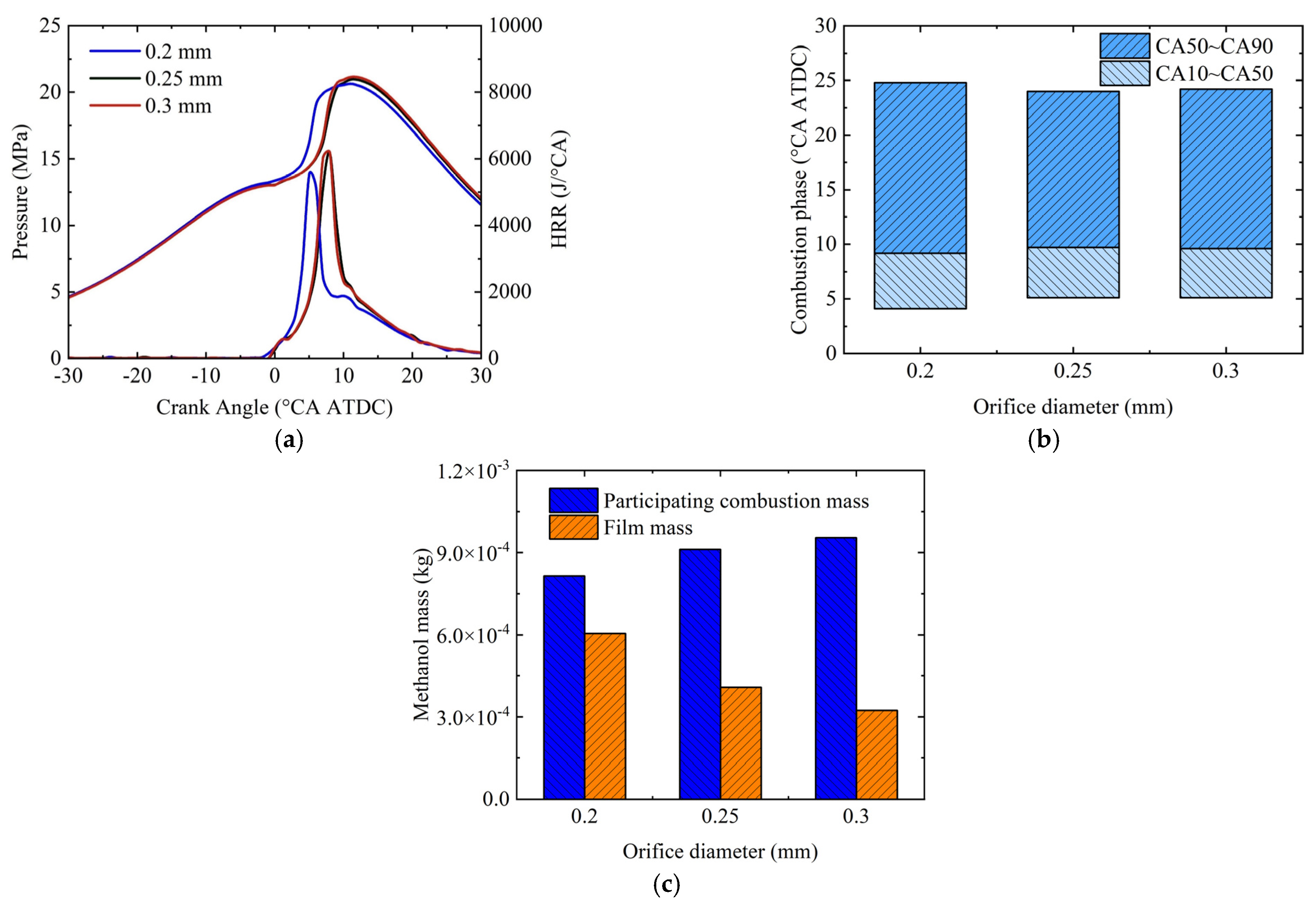

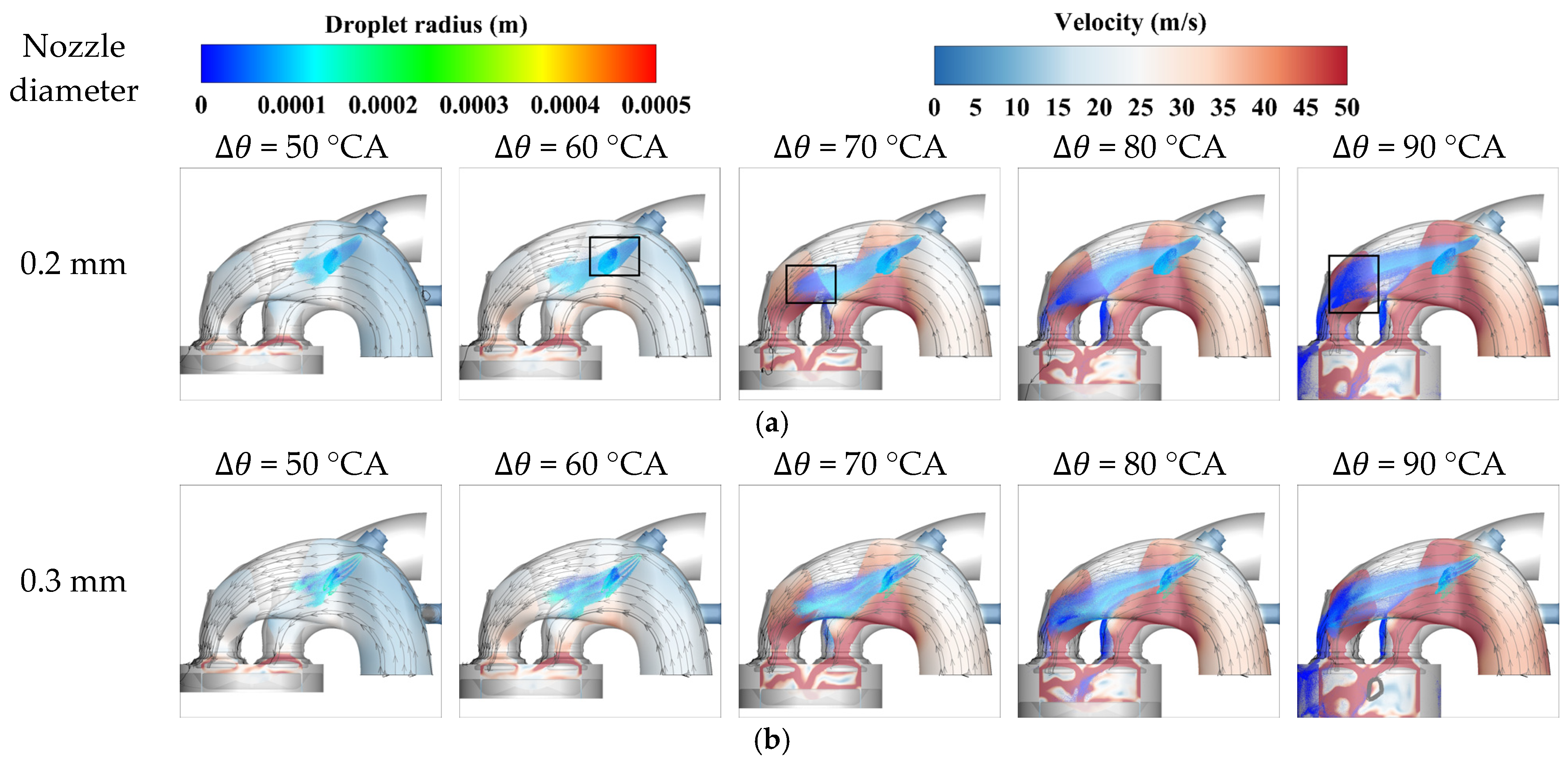
| Parameters | Specifications |
|---|---|
| Engine type | Six-cylinder, four-stroke |
| Bore | 200 mm |
| Stroke | 300 mm |
| Compression ratio | 17.0:1 |
| Intake valve open | −394 °CA ATDC |
| Intake valve close | −177 °CA ATDC |
| Exhaust valve open | 141 °CA ATDC |
| Exhaust valve close | 393 °CA ATDC |
| Parameters | Values |
|---|---|
| SOI/°CA ATDC | −360, −380, −400, −420, −440 |
| Injection pressure/bar | 8, 20, 30, 40, 50 |
| Nozzle diameter/mm | 0.20, 0.25, 0.30 |
Disclaimer/Publisher’s Note: The statements, opinions and data contained in all publications are solely those of the individual author(s) and contributor(s) and not of MDPI and/or the editor(s). MDPI and/or the editor(s) disclaim responsibility for any injury to people or property resulting from any ideas, methods, instructions or products referred to in the content. |
© 2025 by the authors. Licensee MDPI, Basel, Switzerland. This article is an open access article distributed under the terms and conditions of the Creative Commons Attribution (CC BY) license (https://creativecommons.org/licenses/by/4.0/).
Share and Cite
Sun, Z.; Lian, Z.; Ma, J.; Wang, C.; Li, W.; Pan, J. Combustion and Emissions Optimization of Diesel–Methanol Dual-Fuel Engine: Emphasis on Valve Phasing and Injection Parameters. Processes 2025, 13, 1183. https://doi.org/10.3390/pr13041183
Sun Z, Lian Z, Ma J, Wang C, Li W, Pan J. Combustion and Emissions Optimization of Diesel–Methanol Dual-Fuel Engine: Emphasis on Valve Phasing and Injection Parameters. Processes. 2025; 13(4):1183. https://doi.org/10.3390/pr13041183
Chicago/Turabian StyleSun, Zhenyu, Zifan Lian, Jinchun Ma, Chunying Wang, Wei Li, and Jiaying Pan. 2025. "Combustion and Emissions Optimization of Diesel–Methanol Dual-Fuel Engine: Emphasis on Valve Phasing and Injection Parameters" Processes 13, no. 4: 1183. https://doi.org/10.3390/pr13041183
APA StyleSun, Z., Lian, Z., Ma, J., Wang, C., Li, W., & Pan, J. (2025). Combustion and Emissions Optimization of Diesel–Methanol Dual-Fuel Engine: Emphasis on Valve Phasing and Injection Parameters. Processes, 13(4), 1183. https://doi.org/10.3390/pr13041183







